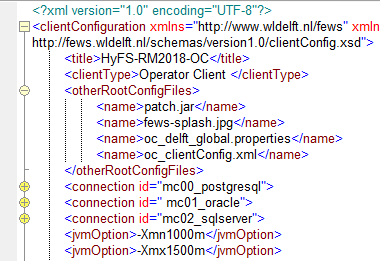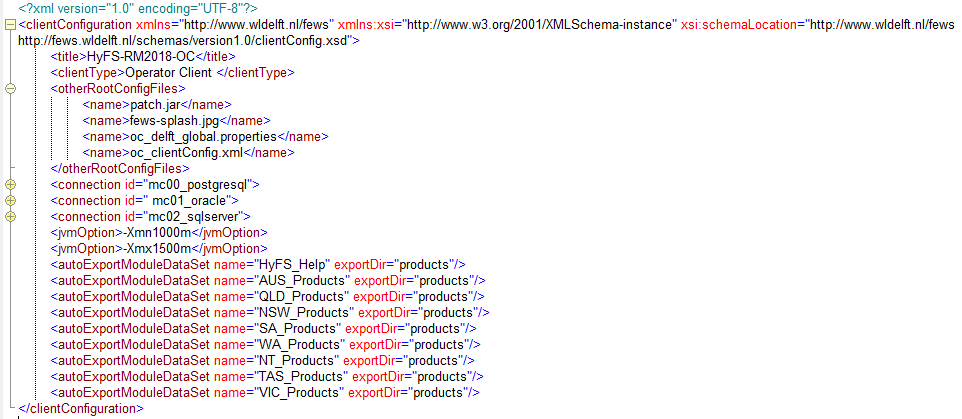Root configuration files
The following root Configuration Files are crucial for either an Operator Client (OC) and a Forecasting Shell Server (FSS)
| RootConfiguration file | OC | FSS |
|---|---|---|
| *_clientConfig.xml | required | required |
| patch.jar | required | required |
| *_global.properties | required | required |
| splash_screen.jpg | recommended | not needed |
A * means either "oc" or "fss"
clientConfig.xml file(s)
From Delft-FEWS 2018.02 onwards, the different clientConfig.xml files have an important place in the Delft-FEWS root configuration. Different variants (for different components) of clientConfig.xml files exist and will be explained below.
The clientConfig.xml consist of the following elements:
title
Optional element for setting the title of your application/component
clientType
Required element for defining the type. Enumeration of options includes;
- Forecasting Shell
- Operator Client
- Stand Alone
otherRootConfigFiles
One or more references to the required root configuration files which should always be downloaded when an OC or FSS starts. For an OC the following root configuration files are important to mention here: patch.jar, oc_global.properties, splash-screen reference and oc_clientConfig.xml. See below mentioned image. Important remark is that when the OC starts, it will be checked if these files are present. If not, the will be downloaded. If they are already there, it will be checked it is the correct active version as in the central database. If the files on the file systems are not the active version, they will be downloaded and overwritten.
connection
Optional element to define the connections to the Master Controller. Only required if you have more than 1 Master Controller connections (multi MC environments).
If there is only 1 Master Controller, the connection details are already within the shortcuts (TO DO: INSERT LINK TO EXPLANATION) you have created when deploying/installing the system.
databaseServer (+ url / user / password)
Required elements for setting the details of the database server if you want to specify those in the <connection>. See example below
<?xml version="1.0" encoding="UTF-8"?>
<clientConfiguration xmlns="http://www.wldelft.nl/fews" xmlns:xsi="http://www.w3.org/2001/XMLSchema-instance" xsi:schemaLocation="http://www.wldelft.nl/fews
http://fews.wldelft.nl/schemas/version1.0/clientConfig.xsd">
<title>HyFS-RM2018-OC</title>
<clientType>Operator Client</clientType>
<otherRootConfigFiles>
<name>patch.jar</name>
<name>fews-splash.jpg</name>
<name>oc_delft_global.properties</name>
</otherRootConfigFiles>
<connection id="mc00_postgresql">
<databaseServer>
<url>jdbc:postgresql://dl-081.xtr.deltares.nl:5432/core00</url>
<user>username</user>
<password>######</password>
</databaseServer>
</connection>
<connection id=" mc01_oracle">
<databaseServer>
<url>jdbc:oracle:thin:@pl-or001.xtr.deltares.nl:1521:rm201802</url>
<user>rm201802</user>
<password>######</password>
</databaseServer>
</connection>
<connection id="mc02_sqlserver">
<databaseServer>
<url>jdbc:jtds:sqlserver://dw-ms002.xtr.deltares.nl:1433;DatabaseName=roadmapmc01;useCursors=false;sendStringParametersAsUnicode=false</url>
<user>fewsuser</user>
<password>######</password>
</databaseServer>
</connection>
<jvmOption>-Xmn1000m</jvmOption>
<jvmOption>-Xmx1500m</jvmOption>
<autoExportModuleDataSet name="HyFS_Help" exportDir="products"/>
<autoExportModuleDataSet name="AUS_Products" exportDir="products"/>
<autoExportModuleDataSet name="QLD_Products" exportDir="products"/>
<autoExportModuleDataSet name="NSW_Products" exportDir="products"/>
<autoExportModuleDataSet name="SA_Products" exportDir="products"/>
<autoExportModuleDataSet name="WA_Products" exportDir="products"/>
<autoExportModuleDataSet name="NT_Products" exportDir="products"/>
<autoExportModuleDataSet name="TAS_Products" exportDir="products"/>
<autoExportModuleDataSet name="VIC_Products" exportDir="products"/>
</clientConfiguration>
jvmOption
Optional element to specify additional java VM options (which were present in the launcher *ini file in earlier versions of Delft-FEWS). In short: all -D and -Xmx options can be configured in individual jvmOptions, example see below.
localCacheSizeMB
Local cache size (in MB) for downloaded timeseries from central database (when NOT using synchronization) or from the Open Archive Server.
localDataStoreFormat
Use this option to generate a local datastore of a specific format. Will (only) be created when no local datastore is present yet and only in case when a synchProfile is present.
Options are: Derby (default), Firebird or HyperSQL.
logging
Option to generate some extra system logging.
warmStatesDirectory
A string path to a accessible directory which holds the warmstates of certain models. In their corresponding general adapter run (model run), a forecasting model can write warmstates to a location on the server (instead of storing it in the database).
proxyAutoConfigScriptContent
Use this option when you want to use your own WPAD script. Use a CDATA block around your script.
proxyAutoConfigScriptUrl
Use this option if a ProxyAutoConfig (PAG) file is located on e.g. your intranet page.
<?xml version="1.0" encoding="UTF-8"?>
<clientConfiguration xmlns="http://www.wldelft.nl/fews" xmlns:xsi="http://www.w3.org/2001/XMLSchema-instance"
xsi:schemaLocation="http://www.wldelft.nl/fews http://fews.wldelft.nl/schemas/version1.0/clientConfig.xsd">
<localDataStoreFormat>Firebird</localDataStoreFormat>
<proxyAutoConfigScriptContent>
<![CDATA[*/
function FindProxyForURL(url, host)
{
return "DIRECT";
}
/*]]>
</proxyAutoConfigScriptContent>
<! -- OR USE -->
<proxyAutoConfigScriptUrl>http://xxxxxxxxxx/wpad.pac</proxyAutoConfigScriptUrl>
</clientConfiguration>
autoExportModuleDataSet
Optional element with references to all ModuleDataSet files which should be extracted when an OC or FSS starts. Mostly valid for FSSs since they are running the models. In case of using the new Web Browser Display this option should also be used to distribute the required libraries for an OC.
In fact: the complete structure on an FSS underneath the "/Modules/" folder should (ideally) be stored in one or more ModuleDataSet files. Only in this way, FSSs can be used for scaling up/down since its content is generated automatically. See below mentioned image with a number of references to ModuleDataSet files
synchProfile
A synchProfile can be defined if you would like to create an OC with LocalDataStore. By default the connection will be Direct Data Access (DDA).
Per synchProfile you can define what should be synched. Most elements are compulsory and can be set to enabled (true/false). Within the timeseries, warmstates, logentries and thresholdevents you can configure a certain maximum age. See config example below.
<?xml version="1.0" encoding="UTF-8"?>
<clientConfiguration xmlns="http://www.wldelft.nl/fews" xmlns:xsi="http://www.w3.org/2001/XMLSchema-instance" xsi:schemaLocation="http://www.wldelft.nl/fews
http://fews.wldelft.nl/schemas/version1.0/clientConfig.xsd">
<title>HyFS-RM2018-OC</title>
<clientType>Operator Client</clientType>
<otherRootConfigFiles>
<name>patch.jar</name>
<name>fews-splash.jpg</name>
<name>oc_delft_global.properties</name>
</otherRootConfigFiles>
<connection id="mc00_postgresql">
<databaseServer>
<url>jdbc:postgresql://dl-081.xtr.deltares.nl:5432/core00</url>
<user>username</user>
<password>######</password>
</databaseServer>
<synchProfileId>full</synchProfileId>
<synchProfileId>minimal</synchProfileId>
</connection>
<connection id=" mc01_oracle">
<databaseServer>
<url>jdbc:oracle:thin:@pl-or001.xtr.deltares.nl:1521:rm201802</url>
<user>rm201802</user>
<password>######</password>
</databaseServer>
<synchProfileId>full</synchProfileId>
<synchProfileId>minimal</synchProfileId>
</connection>
<connection id="mc02_sqlserver">
<databaseServer>
<url>jdbc:jtds:sqlserver://dw-ms002.xtr.deltares.nl:1433;DatabaseName=roadmapmc01;useCursors=false;sendStringParametersAsUnicode=false</url>
<user>fewsuser</user>
<password>######</password>
</databaseServer>
<!-- Uncomment if synchronisation is desired -->
<synchProfileId>full</synchProfileId>
<synchProfileId>minimal</synchProfileId>
</connection>
<synchProfile id="full">
<xmlConfig enabled="true" name="Default xml config" synchLevel="11"/>
<coldStates enabled="true" name="Default cold states" synchLevel="11"/>
<moduleDataSets enabled="true" name="Default module data sets" synchLevel="11"/>
<mapLayers enabled="true" name="Default module data sets" synchLevel="11"/>
<icons enabled="true" name="Default icons" synchLevel="11"/>
<reportTemplates enabled="true" name="Default report templates" synchLevel="11"/>
<reportImages enabled="true" name="Default report images" synchLevel="11"/>
<continuousTimeSeries enabled="true" name="Telemetry" synchLevel="1" maxAge="10" unit="day"/>
<continuousTimeSeries enabled="true" name="Manual" synchLevel="5" maxAge="10" unit="day"/>
<continuousTimeSeries enabled="true" name="Astronomical and climatological" synchLevel="4" maxAge="1000" unit="day"/>
<continuousTimeSeries enabled="true" name="Small external forecast grids" synchLevel="6" maxAge="10" unit="day"/>
<continuousTimeSeries enabled="true" name="Large external forecast grids" synchLevel="16" maxAge="10" unit="day"/>
<forecastTriggeredTimeSeries name="Simulated forecast time series" enabled="true" synchLevel="0"/>
<warmStates enabled="true" name="Warm states" maxAge="10" unit="day"/>
<logEntries enabled="true" name="Log Entries" maxAge="10" unit="day"/>
<thresholdEvents enabled="true" name="Threshold Events" maxAge="10" unit="day"/>
</synchProfile>
<synchProfile id="minimal">
<xmlConfig enabled="true" name="Default xml config" synchLevel="11"/>
<coldStates enabled="true" name="Default cold states" synchLevel="11"/>
<moduleDataSets enabled="false" name="Default module data sets" synchLevel="11"/>
<mapLayers enabled="true" name="Default module data sets" synchLevel="11"/>
<icons enabled="true" name="Default icons" synchLevel="11"/>
<reportTemplates enabled="false" name="Default report templates" synchLevel="11"/>
<reportImages enabled="false" name="Default report images" synchLevel="11"/>
<continuousTimeSeries enabled="true" name="Telemetry" synchLevel="1" maxAge="1" unit="day"/>
<continuousTimeSeries enabled="true" name="Manual" synchLevel="5" maxAge="1" unit="day"/>
<continuousTimeSeries enabled="true" name="Astronomical and climatological" synchLevel="4" maxAge="1000" unit="day"/>
<continuousTimeSeries enabled="false" name="Small external forecast grids" synchLevel="6" maxAge="10" unit="day"/>
<continuousTimeSeries enabled="false" name="Large external forecast grids" synchLevel="16" maxAge="10" unit="day"/>
<forecastTriggeredTimeSeries name="Simulated forecast time series" enabled="true" synchLevel="0"/>
<warmStates enabled="false" name="Warm states" maxAge="10" unit="day"/>
<logEntries enabled="true" name="Log Entries" maxAge="1" unit="day"/>
<thresholdEvents enabled="true" name="Threshold Events" maxAge="1" unit="day"/>
</synchProfile>
</clientConfiguration>
externalTables
Here you can indicate whether you are using an 'external' (= non-blobbed) database for: Parameters, Locations, Qualifiers and External Historical Timeseries. You have to specify the connection details to this (database) server here.
Example ClientConfiguration
<?xml version="1.0" encoding="UTF-8"?>
<clientConfiguration xmlns="http://www.wldelft.nl/fews" xmlns:xsi="http://www.w3.org/2001/XMLSchema-instance" xsi:schemaLocation="http://www.wldelft.nl/fews
http://fews.wldelft.nl/schemas/version1.0/clientConfig.xsd">
<title>my Delft-FEWS SA</title>
<clientType>Stand alone</clientType>
<jvmOption>-Xmn1000m</jvmOption>
<jvmOption>-Xmx1500m</jvmOption>
</clientConfiguration>
<?xml version="1.0" encoding="UTF-8"?>
<clientConfiguration xmlns="http://www.wldelft.nl/fews" xmlns:xsi="http://www.w3.org/2001/XMLSchema-instance" xsi:schemaLocation="http://www.wldelft.nl/fews
http://fews.wldelft.nl/schemas/version1.0/clientConfig.xsd">
<title>my Delft-FEWS OC</title>
<clientType>Operator Client</clientType>
<otherRootConfigFiles>
<name>oc_global.properties</name>
<name>patch.jar</name>
<name>help.pdf</name>
<name>fews-splash.jpg</name>
</otherRootConfigFiles>
<jvmOption>-Xmn1000m</jvmOption>
<jvmOption>-Xmx1500m</jvmOption>
<!-- ONLY IF MODULEDATASETS NEED TO BE EXTRACTED ON STARTUP -->
<autoExportModuleDataSet name="X" exportDir="X"/>
</clientConfiguration>
<?xml version="1.0" encoding="UTF-8"?> <clientConfiguration xmlns="http://www.wldelft.nl/fews" xmlns:xsi="http://www.w3.org/2001/XMLSchema-instance" xsi:schemaLocation="http://www.wldelft.nl/fews http://fews.wldelft.nl/schemas/version1.0/clientConfig.xsd"> <title>my Delft-FEWS FSS</title> <clientType>Forecasting Shell</clientType> <otherRootConfigFiles> <name>fss_global.properties</name> <name>patch.jar</name> </otherRootConfigFiles> <!-- ONLY IF MODULEDATASETS NEED TO BE EXTRACTED ON STARTUP --> <autoExportModuleDataSet name="X" exportDir="X"/> </clientConfiguration>


